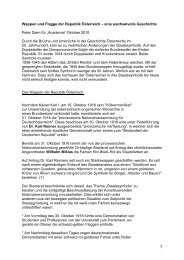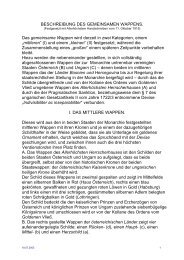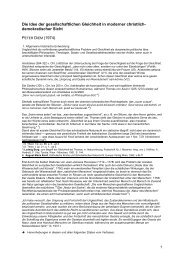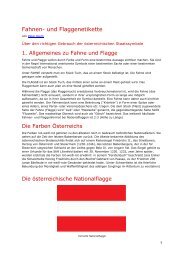The Symbols of Europe (.pdf English) - Dr. Peter Diem
The Symbols of Europe (.pdf English) - Dr. Peter Diem
The Symbols of Europe (.pdf English) - Dr. Peter Diem
You also want an ePaper? Increase the reach of your titles
YUMPU automatically turns print PDFs into web optimized ePapers that Google loves.
<strong>The</strong> <strong>Symbols</strong> <strong>of</strong> <strong>Europe</strong>HistoryMeaningChances<strong>Peter</strong> <strong>Diem</strong>,August 2004http://peter-diem.at1
<strong>The</strong> Functions <strong>of</strong> Political <strong>Symbols</strong>• InformationJust like trademarks, logos, or other symbols <strong>of</strong>“corporate identity“, political symbols tell „in a nutshell“what kind <strong>of</strong> „product“ one is confronted with• IdentityFlags, anthems and national holidays have kepttheir function to create a feeling <strong>of</strong> “belonging“• IntegrationNational symbols help to unite a nation, especiallywhen it is composed <strong>of</strong> various races and religions.• InternationalInternational symbols intend to promotepeace and cooperation between races,cultures, and nations.e pluribus unum2
<strong>The</strong> Olympic Rings<strong>The</strong> rings were created by Baron Pierre de Coubertin (founder <strong>of</strong> the modernOlympic Movement) in 1913 . In a white field, they symbolize peaceful contestamong the five major regions <strong>of</strong> the world: the Americas, Asia, Africa, <strong>Europe</strong>,and Australia. Coubertin never said that the colours <strong>of</strong> the rings were linkedwith the five continents, but more <strong>of</strong>ten than not they are interpreted in thismanner.<strong>The</strong> Olympic Flag made its debut at the 1920 Olympic Games in Antwerp –hence it is also referred to as the „Antwerp Flag“.3
After the Cataclysm <strong>of</strong> World War I –a Nobleman‘s Vision„Paneuropa“Richard N. Count Coudenhove-KalergiBook published in 1923 by (1894-1972).<strong>The</strong> Paneuropa Movement had its central <strong>of</strong>fice in Vienna‘s H<strong>of</strong>burg until 1938.4
Interpretations <strong>of</strong> the Paneuropa Symbol<strong>The</strong> sun symbol is possibly also connected to C-K‘s Japanese mother and to buddhism5
<strong>The</strong> League <strong>of</strong> NationsFounded in 1920, at first no emblem could be agreed uponIn a 1929/30 contest 1640 proposals were submitted, but n<strong>of</strong>irst prize was granted. <strong>The</strong> above designs came second.League <strong>of</strong> Nations Covenant6
<strong>The</strong> League <strong>of</strong> Nations at New York 1939<strong>The</strong> League <strong>of</strong> Nations was unable to agree on a commonsymbol. Only in 1939, the flag shown above was used for ashort period in New York. It contains these typical elements:the colors blue and white (for peace), the five-pointed star (forfreedom and brotherhood), and the pentagram (symbolizinghappiness and pointing to the five continents).7
<strong>The</strong> Flag <strong>of</strong> the United NationsUnlike the League <strong>of</strong> Nations, the UN sought from the very beginning toagree on a common symbol. It was published by the General Assemblyon 20th October, 1947http://www.un.org/depts/dhl/maplib/flag.html8
Description <strong>of</strong> the UN Flag<strong>The</strong> United Nations emblem was first approved on 7 December 1946.<strong>The</strong> design is "a map <strong>of</strong> the world representing an azimuthal equidistantprojection centred on the North Pole, inscribed in a wreath consisting <strong>of</strong>crossed conventionalized branches <strong>of</strong> the olive tree, in gold on a field <strong>of</strong>smoke-blue with all water areas in white. <strong>The</strong> projection <strong>of</strong> the mapextends to 60 degrees south latitude, and includes five concentric circles".Olive branches symbolize peace. <strong>The</strong> world map depicts the area <strong>of</strong> concernto the United Nations in achieving its main purpose, peace and security.http://www.un.org/depts/dhl/maplib/flag.html9
<strong>Europe</strong> after World War IIDuncan Sandys10
<strong>The</strong> Council <strong>of</strong> <strong>Europe</strong> 1950Council <strong>of</strong> <strong>Europe</strong>11
<strong>The</strong> Council <strong>of</strong> <strong>Europe</strong> 1955Council <strong>of</strong> <strong>Europe</strong>12
<strong>The</strong> Council <strong>of</strong> <strong>Europe</strong> 1955“Since its foundation in 1949, the Council <strong>of</strong> <strong>Europe</strong> has been aware <strong>of</strong> the need togive <strong>Europe</strong> a symbol with which its inhabitants can identify. On 25 October 1955 theParliamentary Assembly made the unanimous decision to adopt a circle <strong>of</strong> gold starson a blue background as an emblem. On 8 December 1955 the Committee <strong>of</strong>Ministers adopted this as the <strong>Europe</strong>an flag.”„Against the blue sky <strong>of</strong> the Western world, the stars represent the peoples <strong>of</strong> <strong>Europe</strong>in a circle, the symbol <strong>of</strong> unity. <strong>The</strong>ir number shall be invariably set at twelve, thesymbol <strong>of</strong> completeness and perfection ... just like the twelve signs <strong>of</strong> the zodiacrepresent the whole universe, the twelve gold stars stand for all peoples <strong>of</strong> <strong>Europe</strong> –including those who cannot as yet take part in building up <strong>Europe</strong> in unity and peace.“Council <strong>of</strong> <strong>Europe</strong>13
11th April, 1983:<strong>The</strong> <strong>Europe</strong>an Parliament accepts the flag asthe <strong>of</strong>ficial emblem <strong>of</strong> the <strong>Europe</strong>an Union<strong>The</strong> correct proportion is 2:3 as presented abovehttp://www.europa.eu.int/abc/symbols/emblem/index_en.htm14
Symbolic elements – „Old“ International OrganisationsColours: White, light blue, goldForms: Map, circle(s), five-pointed star(s)Number: 5 continentsPrototype: Olive branch, Olympic circlesSymbolic elements – <strong>Europe</strong>an UnionColours: cobalt blue, goldForms: circle, five-pointed starsNumber: 12 perfection, completenessPrototype: blue and gold, stars and circlesSymbolismGreen = youth, ecology, general hope for a better worldLight blue = sea, sky remote hope for peaceDark blue = security, order realistic hope for peaceGold stars = brotherhood; Sun = empire)Connection <strong>of</strong> stars with Apocalypse 12,1 is a myth.http://www.europa.eu.int/abc/symbols/emblem/index_en.htm15
<strong>The</strong> <strong>Europe</strong>an Anthem<strong>The</strong> <strong>Europe</strong>an Anthem (Ode to Joy) - adapted from the finalmovement <strong>of</strong> Beethoven's 9th Symphony - was adopted by theCouncil <strong>of</strong> <strong>Europe</strong> in 1972 and has been used by the <strong>Europe</strong>anUnion since 1986. Herbert von Karajan, one <strong>of</strong> the greatestconductors <strong>of</strong> this century, acceded to a request by theCouncil <strong>of</strong> <strong>Europe</strong> to write three instrumental arrangements forsolo piano, wind and symphonic orchestras. It was recorded atTeatro da Trindade - Lisboa – 1994:Play or download anthem16
A Predecessor <strong>of</strong> the <strong>Europe</strong>anAnthemOne might remember the „fanfare“ used by the <strong>Europe</strong>anBroadcasting Union (EBU) to introduce and conclude<strong>Europe</strong>an sports transmissions, the New Year‘s Concert,the Eurosong Contest etc.This very well known tune was taken from the „Te Deum“<strong>of</strong> the French composer <strong>of</strong> baroque music, Marc-AntoineCharpentier (1643-1704). It was introduced by the EBU in1950.17
Die Europahymne auf DeutschUnser Herz schlägt für EuropaUnd wir stehen dafür ein,Dass dem Erdteil es gelinge,In der Vielfalt eins zu sein.Ewig währen in EuropaFriede und Gerechtigkeit,Und die Freiheit seiner VölkerSei verbrieft auf alle Zeit.Blühe, Vaterland Europa,Bringt das große Werk voran!Sternengold im blauen Banner,Dieses Zeichen führt uns an.<strong>Peter</strong> <strong>Diem</strong>, Wien10. Oktober 200418
<strong>The</strong> <strong>Europe</strong>an Anthem in <strong>English</strong>Unity has come to <strong>Europe</strong>,Unity is here to stay.Unity is our future –Long live <strong>Europe</strong>, come what may!North and south will work togetherJust as friends and neighbours should.East and West will grow together –Brotherhood and sisterhood!<strong>Europe</strong>, may your peoples flourish,Let the common banner rise!Stars <strong>of</strong> gold and blue <strong>of</strong> sky/:Are the colours that we prize.<strong>Peter</strong> <strong>Diem</strong> (Vienna)19
<strong>The</strong> <strong>Europe</strong>an Anthem in LatinEST EUROPA NUNC UNITAET UNITA MANEAT;UNA IN DIVERSITATEPACEM MUNDI AUGEAT.SEMPER REGANT IN EUROPAFIDES ET IUSTITIAET LIBERTAS POPULORUMIN MAIORE PATRIA.CIVES, FLOREAT EUROPA,OPUS MAGNUM VOCAT VOS.STELLAE SIGNA SUNT IN CAELOAUREAE, QUI IUNGANT NOS.Authors: <strong>Peter</strong> Roland and <strong>Peter</strong> <strong>Diem</strong> Cf.: http://www.hymnus-europae.at20
On 5th May 1949, the Council <strong>of</strong> <strong>Europe</strong> was founded.For many years, this day was commemorated bymember parliaments as „Day <strong>of</strong> <strong>Europe</strong>“.During their Milan Summit in June 1985, EU leadersdecided to choose the 9th <strong>of</strong> May as "<strong>Europe</strong> Day“.On 9th May 1950, the Schuman Plan was presentedin Paris. This occasion is considered to be the startingpoint <strong>of</strong> the process <strong>of</strong> <strong>Europe</strong>an unification.<strong>Europe</strong> Day21
<strong>Europe</strong>an Licence PlatesCf: some licence plates from <strong>Europe</strong>22
<strong>The</strong> Euro - a Tangible Symbol <strong>of</strong> UnityIn contrast to abstract symbols, the Euro isa tangible pro<strong>of</strong> <strong>of</strong> <strong>Europe</strong>an unity –economically and psychologically,especially when travelling through <strong>Europe</strong> –and even beyond the borders <strong>of</strong> the EU.Unlike the totally „supranational“ banknotes, the Euro coins are„<strong>Europe</strong>an“ only on one side whereas the reverse has beenreserved to bear national design.This has been interpreted as a bad compromise – but respectingnational sovereignty <strong>of</strong> the mint can also be seen as anexpression <strong>of</strong> a federalist concept <strong>of</strong> the <strong>Europe</strong>an Union:„in pluribus unum“ vs. „e pluribus unum“<strong>The</strong> Euro Website23
<strong>The</strong> Euro BanknotesDesigned by the Austrian artist Robert Kalina the Euro banknotesshow two sets <strong>of</strong> symbols with similar connotations:Window/Door – as the symbols <strong>of</strong> openness, freshnessand the invitation to join<strong>The</strong> Bridge – as the symbol <strong>of</strong> connecting opposites,overcoming difficulties, and uniting peopleReferring to the cultural traditions <strong>of</strong> <strong>Europe</strong>, seven periods <strong>of</strong> artand architecture are being quoted: Classical, Romanesque,Gothic, Renaissance, Baroque, Industrial, Contemporary<strong>The</strong> Euro Website24
<strong>The</strong> Euro Sign and Coins<strong>The</strong> common side <strong>of</strong> the coins was designed by Luc Luycx <strong>of</strong> the RoyalBelgian Mint. It depicts a map <strong>of</strong> the <strong>Europe</strong>an Union against abackground <strong>of</strong> parallel lines linking the 12 stars <strong>of</strong> the <strong>Europe</strong>an Union flag.<strong>The</strong> national side <strong>of</strong> the Euro used in Greece shows Európe beingabducted to Crete by25
Conclusions• Use <strong>of</strong> the symbols <strong>of</strong> <strong>Europe</strong> is part <strong>of</strong> the efforts to enhancethe (emotional) acceptance <strong>of</strong> the idea <strong>of</strong> <strong>Europe</strong>an unity.• What adult education can do :- inform the public about the meaning <strong>of</strong> the EU symbols- fly your national flag always together with the <strong>Europe</strong>an flag- open <strong>of</strong>ficial meetings with national and <strong>Europe</strong>an anthems- print flag or „<strong>Europe</strong>an“ logo on conference papers- put „<strong>Europe</strong>an“ links on your Web site- commemorate the 9th <strong>of</strong> May with some „<strong>Europe</strong>an“ initiative- „europeanize“ your national holiday ( „neigbourhood day“)- invite (your) Members <strong>of</strong> the <strong>Europe</strong>an Parliament (MEP)- organize a contest to find lyrics to the <strong>Europe</strong>an Anthem- fight against all national stereotypes and prejudices26
Long live <strong>Europe</strong>!http://peter-diem.at27






